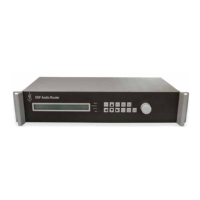VAR8 and Variants Operation, Commissioning, Fault Finding, and Maintenance Guide
sue: 02 complete, approved
-
Is
Page 116 of 166
24.9 RS232 Asynchronous Port Configuration
The RS232 port is internally used for network connection when the unit is networked. This port can be
temporarily disconnected from the network, and connected to a PC for configuration and diagnose purposes.
On stand-alone units the RS232 port can be used to connect to equipment such as PC/DVA system, and to
PCs running remote fault reporting software.
It is possible to define whether the RS232 port connection is direct or via a modem, and whether or not to
implement hardware flow control (i.e. suspend transmission when CTS is not asserted), as described in the
following steps.
The default communications parameters are: 9600 bps, no parity, 8 data bits, 1 stop bit.
To Configure the RS232 Port:
9. Set the RS232 port for the required operation:
a. Network operation:
Menu: ConfigurationÆSystemÆMiscÆAsync-PortÆConnect to network
b. Stand-alone operation or direct connection to host PC:
Menu: ConfigurationÆSystemÆMiscÆAsync-PortÆConnect to PC Direct
Note that after performing the required configuration, the RS232 port needs to be reconfigured to
Connect to network if the unit is networked.
c. Stand-alone operation or connection to host PC via modem:
Menu: ConfigurationÆSystemÆMiscÆAsync-PortÆConnect to PC via modem
Note that after performing the required configuration, the RS232 port needs to be reconfigured to
Connect to network if the unit is networked.
10. Normally the CTS, i.e., use of hardware flow control, is set to disabled.
Menu: ConfigurationÆSystemÆMiscÆAsync-PortÆCTS disabled

